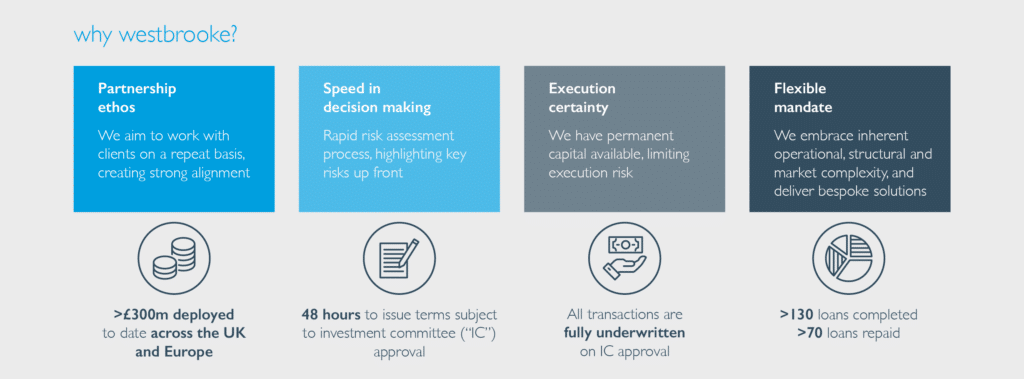By: Westbrooke Alternative Asset Management Source: Moneyweb
Section 12J funds provide substantial tax relief to qualifying investors.
Since 2015, when treasury made a number of favourable changes to the Section 12J tax legislation, Section 12J companies have experienced considerable growth and popularity in the SA market. Westbrooke Alternative Asset Management has become the largest Section 12J asset manger in the industry, by combining the tax benefits afforded by the structure, with a bouquet of lower-risk, asset-backed funds that provide exposure to asset classes that are not easily accessed from more traditional investments, but that have investment returns that are equally as attractive on a risk-adjusted basis
Section 12J funds provide substantial tax relief to qualifying investors. Established by government to stimulate investment into, and the growth of, small- and medium-sized enterprises in select industries, s12J incentivises taxpayers to make investments into registered Section 12J “venture capital companies” in order to offset their tax liability or a portion thereof. Any investment made into a Section 12J company by a private investor can be deducted against any and all taxable income incurred in the year that the investment is made.
Taking the current tax year to end February, an investor who has a marginal tax rate of 45% would be able to shield R450 000 of tax should they invest R1 million into an approved Section 12J company, with the caveat that they must hold the investment for a minimum period of five years. The investment is available to individuals, companies and trusts and can be offset against all types of taxable income, which makes it particularly attractive to those who have incurred capital gains tax during the year (more on this later). For provisional tax payers who submit returns at the end of February, the tax benefit can even be deducted from the tax liability before provisional payments are made.
The tax benefit fundamentally changes the target return profile of the investment. Using the earlier example, a R1 million investment into a Section 12J company for a person with a marginal tax rate of 45% essentially means the individual makes a net investment of R550 000. This is because the tax man is essentially funding the R450 000, because instead of paying Sars R450 000, you are investing it in a Section 12J company.
But there is a small catch. When you sell your investment at the end of five years, you will be liable to pay capital gains tax with the entire investment calculated as a gain. So, assuming the fund keeps the money intact in our example, and pays R1 million back after five years, this amount is then multiplied by an inclusion rate (40% for individuals and 80% for companies) and then multiplied by your marginal tax rate. This equates to a capital gains tax liability of R180 000 on an investment of R1 million for an investor that pays tax at the maximum marginal rate of 45%, which means the investor will receive R820 000 after tax at the end of the five year investment period. The annualised return for the investor in such a scenario equates to 8.3% per annum (R550 000 compounded by 8.3% annually for five years will reach R820 000) and may be further enhanced by any returns generated by the underlying businesses in which the s12J company is invested. However, it must be noted by any potential investor that Section 12J investments are private equity in nature and therefore returns of the investment are dependent on the performance of the Section 12J’s underlying investments.
With a return like this already implicit at the start of the investment, the investment manager does not need to take any undue risk to generate attractive returns. “We are deliberately conservative. Our core focus is to preserve capital. We absolutely do not want to lose money, and that is part of the reason why we invest in asset-backed investments which include things like property and moveable assets, because they will always inherently have some value attached to them. While still fulfilling the mandate to stimulate private investment into the South African economy,” says Dino Zuccollo, who focuses on property investments on behalf of Westbrooke.
This makes a lot of sense. If, just by virtue of the tax incentive available in Section 12J funds alone, your money is growing at 8.3% a year, the non-tax return only needs to keep up with inflation in order to generate returns you would expect from the stock market. “So we are happy to accept lower returns for lower risk because relative to other asset classes available to investors, the overall return is still very attractive,” says Zuccollo.
But does a tax incentive alone make an investment attractive? “This is patently wrong,” says Jonti Osher, who specialises in managing Westbrooke’s asset rental and hospitality investments. “Generally investors would invest in these industries even if there was no Section 12J benefit,” he adds. Westbrooke has identified moveable asset rentals, student accommodation and certain hospitality opportunities as industries from which suitable risk-adjusted returns can be generated.
These are encapsulated in the three funds it still has open for investment in the current tax year:
- Westbrooke Aria (alternative rental income assets), now in its third edition, invests in companies that offer moveable assets, like vehicles and equipment, on medium- and long-term operating rentals. “The attractive feature of the underlying moveable asset is that there are usually contractual revenue streams, so you can understand what the return will be upfront. For example, we already provide growth capital to a company that rents, services and maintains scooters used by Famous Brand franchisees,” says Osher.
- Westbrooke Stac (student accommodation) partners with operators of student accommodation operations in close proximity to tertiary education institutions in large cities including Pretoria, Johannesburg, Cape Town and Stellenbosch. “We partner with established operators. The properties pay a stable dividend stream, are fixed-property backed, and it is a form of accommodation for which there is very strong demand in South Africa,” says Zuccollo.
- Westbrooke Alto (alternative tourism) specifically looks to invest in residential hotel properties in attractive areas in Cape Town, with the properties being let via platforms like Airbnb and TripAdvisor. “The focus of the fund is to stimulate the Cape Town tourism sector and to generate capital growth for investors, with the end goal being to sell the residential hotel properties at a much higher price at the end of the investment period,” says Osher.
Besides understanding the investment mandate of the fund and the skill and experience of the asset manager, investors also need to be aware of how the fund will exit its investments. This is the one aspect of investing in Section 12J funds that is potentially more complex than the stock market.
Zuccollo explains that various options are conceived far in advance of the fund needing to liquidate. “In five years’ time, we might want to list the student accommodation fund, which means it will become a listed share and the investor can retain the investment or sell it. Another option would be to sell the portfolio to a large listed property fund for which the investor would receive shares. Alternatively, the fund could sell the portfolio to a private investor and cash out, so it needs to be considered and understood as each fund will have a different exit mechanism.”
In terms of the amount money that can be invested in a Section 12J, Westbrooke imposes its own minimum amount of R500 000. On the upper end, the only restriction applicable to size is that no single investor can own more than 20% of a fund.












